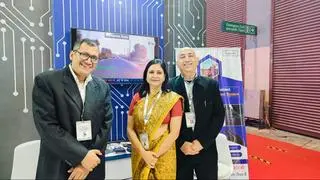When building a large solar plant, spread across acres, even imperceptible inconsistencies in the construction matters. For instance, a mere millimetric variation in the height of the piles — the structures that support the solar panels — can affect the flatness of the arrays and, in turn, impact performance. Similar is the need to ensure that the rows of panels are exactly parallel.
A lapse of any kind costs dear — a solar developer building a 2,500-acre plant in Rajasthan spent $30,000 to redo a large chunk of it.
Datasee.AI, a start-up that operates from Chennai and Atlanta, USA, came up with a solution — use of drones to monitor construction quality.
Apart from the now commonplace use of drone photography, Datasee uses artificial intelligence and machine learning models to interpret the image data. Its clients include several solar developers in the US, Europe and West Asia. Of the 18-GW orders it has in hand, 10.5 GW is from overseas. The company says it is in talks for another 22-GW new orders.
Datasee provides clients a software-based platform that collects geospatial information about their solar projects, right from the early stages. Post construction, the same imaging technology is used to detect defects that may crop up in the solar plant.
The image collection is through infrared or plain RGB cameras mounted on drones. The software stitches together the images for analysis. AI-based analysis spots inconsistencies in the construction of the solar plant.
Ahead of construction, the images can also precisely map the topography of the land, including minor undulations.
Fault analytics
Bhaskar Raghunathan, founder and CEO, Datasee, says the start-up can provide the “elevation profile of the land to centimetre-level precision” to aid precise construction. Even slight misalignments could cause problems in robotic cleaning of solar assets or affect tracker efficiency.
Once the plant is constructed, the drones collect images to help detect heat signatures (defects known as hotspots), if any. Each of these heat signatures could denote a particular defect. A machine learning model identifies these defects and (by comparing with similar defects in the database) can advise the client on ways to correct them.
Raghunathan’s experience with imaging began during his master’s programme in product design at the Indian Institute of Science, Bengaluru, where he worked on image processing (mainly medical images). He went on to design a drone for image collection, which earned him four patents. Today, Raghunathan is one of the evaluators who issue ‘type certification’ for drones that enter the market. With the expertise in drones and imaging under his belt, he decided to apply it in yet another area of his passion — renewable energy. Datasee was born in 2017.
“We are the first identifiers of the problems, giving the first-level estimate of a module failure; we are the doctors of solar assets,” says Raghunathan.







Comments
Comments have to be in English, and in full sentences. They cannot be abusive or personal. Please abide by our community guidelines for posting your comments.
We have migrated to a new commenting platform. If you are already a registered user of TheHindu Businessline and logged in, you may continue to engage with our articles. If you do not have an account please register and login to post comments. Users can access their older comments by logging into their accounts on Vuukle.